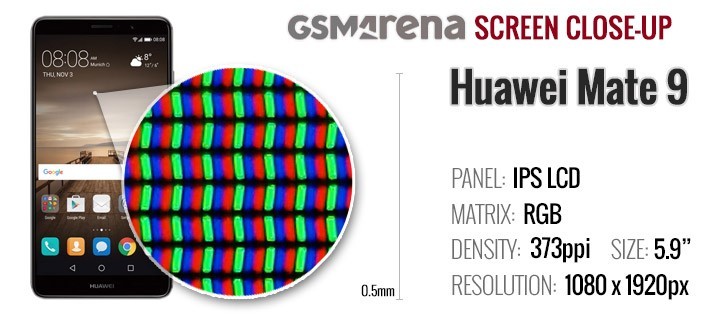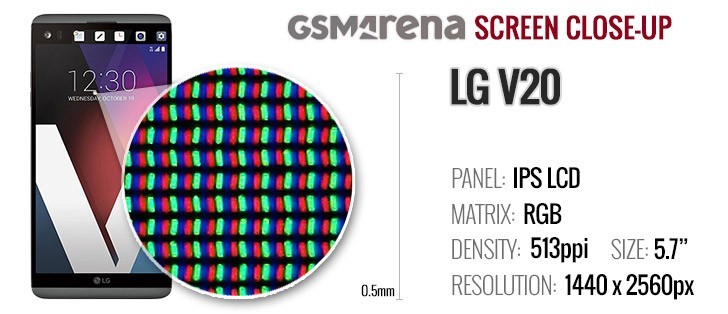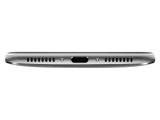LG V20 v. Huawei Mate 9: Camera-derie between rivals
Camera-derie between rivals

Screen
While Huawei has dabbled with OLED, it chose an IPS LCD for the Mate 9. The LG V20 also uses an IPS screen but both are at very different resolutions - QHD/513ppi for the V20, 1080p/373ppi for the Mate 9. We think 1080p is a bit of a stretch at 5.9", but it works out well enough (if it was an OLED, the PenTile matrix would have been an issue).

The Mate 9 screen offers superb contrast, topped by very few devices - 1,600:1, compared to LG V20's 1,100:1. The maximum brightness of both is pretty close, but the Huawei has deeper blacks. Images really pop on this display.
| Display test | 100% brightness | ||
| Black, cd/m2 | White, cd/m2 | ||
| 0.43 | 475 | 1097 | |
| 0.59 | 628 | 1064 | |
| 0.41 | 665 | 1622 | |
Both displays are hurt by the reflectivity of the glass above them - the LG V20 more than the Mate 9. So even though the sunlight numbers appear fairly close, in practice we had an easier time reading the Huawei display. Also, it gives you full control over the entire range of brightness while with the LG you get the peak brightness levels only when the Auto brightness mode decides to go into overdrive.
Sunlight contrast ratio
-
Samsung Galaxy S6 edge+
4.615 -
Samsung Galaxy S7 edge
4.439 -
OnePlus 3
4.424 -
Samsung Galaxy S7
4.376 -
HTC One A9
4.274 -
Samsung Galaxy Note7
4.247 -
Samsung Galaxy A3
4.241 -
OnePlus 3T
4.232 -
Google Pixel XL
4.164 -
ZTE Axon 7
4.154 -
Samsung Galaxy S6 edge
4.124 -
Samsung Galaxy Note5
4.09 -
Huawei Nexus 6P
4.019 -
OnePlus X
3.983 -
Vivo Xplay5 Elite
3.983 -
Oppo R7s
3.964 -
Apple iPhone 7
3.964 -
Huawei P9 Plus
3.956 -
Meizu Pro 6 Plus
3.935 -
Lenovo Moto Z
3.931 -
Samsung Galaxy A7 (2016)
3.918 -
Samsung Galaxy C5
3.911 -
Samsung Galaxy C7
3.896 -
Samsung Galaxy A5
3.895 -
Samsung Galaxy J7 outdoor
3.879 -
Samsung Galaxy J2 outdoor
3.873 -
Samsung Galaxy A8
3.859 -
Samsung Galaxy A9 (2016)
3.817 -
Motorola Moto X (2014)
3.816 -
Samsung Galaxy A5 (2017)
3.804 -
Samsung Galaxy J7 (2016) outdoor mode
3.802 -
LG V20 Max auto
3.798 -
Xiaomi Redmi Pro
3.798 -
Sony Xperia XZ
3.795 -
Samsung Galaxy A5 (2016)
3.789 -
Apple iPhone 6s
3.783 -
Meizu Pro 5
3.781 -
Microsoft Lumia 650
3.772 -
Samsung Galaxy J7 (2016)
3.756 -
Oppo F1 Plus
3.709 -
Vivo X5Pro
3.706 -
Sony Xperia X Compact
3.694 -
Samsung Galaxy A3 (2017)
3.688 -
Apple iPhone SE
3.681 -
Huawei Mate 9
3.68 -
Samsung Galaxy A7
3.679 -
Meizu PRO 6
3.659 -
BlackBerry Priv
3.645 -
Apple iPhone 7 Plus
3.588 -
Apple iPhone 6s Plus
3.53 -
Motorola Moto Z Play
3.526 -
Samsung Galaxy J3 (2016)
3.523 -
Samsung Galaxy J3 (2016) outdoor mode
3.523 -
Acer Jade Primo
3.521 -
Microsoft Lumia 950
3.512 -
Oppo R7 Plus
3.499 -
nubia Z11
3.466 -
Samsung Galaxy J7
3.422 -
Meizu MX5
3.416 -
LG V20
3.402 -
Oppo R9s
3.352 -
Oppo R7
3.32 -
Lenovo P2
3.316 -
Xiaomi Mi 5s
3.276 -
Samsung Galaxy J2
3.235 -
Sony Xperia X Performance
3.234 -
Xiaomi Mi Note 2
3.228 -
Motorola Moto X Play
3.222 -
Huawei P9
3.195 -
Lenovo Vibe Shot
3.113 -
Motorola Moto X Force
3.105 -
LG Nexus 5X
3.092 -
Huawei Mate S
3.073 -
Microsoft Lumia 640 XL
3.065 -
Sony Xperia X
2.989 -
Huawei Mate 8
2.949 -
Xiaomi Redmi 3S
2.913 -
Sony Xperia XA Ultra
2.906 -
LG G5
2.905 -
HTC One S
2.901 -
Xiaomi Redmi 3s Prime
2.893 -
Xiaomi Mi 5s Plus
2.884 -
Sony Xperia Z5
2.876 -
Microsoft Lumia 550
2.851 -
Lenovo Moto M
2.813 -
Xiaomi Redmi 3 Pro
2.803 -
Sony Xperia Z5 compact
2.784 -
Meizu MX6
2.751 -
LG V10
2.744 -
Xiaomi Redmi 3
2.735 -
Sony Xperia M5
2.69 -
Huawei P9 Lite
2.679 -
Xiaomi Redmi 4 Prime
2.679 -
Vivo V3Max
2.659 -
Xiaomi Mi Mix
2.658 -
Xiaomi Mi 4i
2.641 -
Sony Xperia XA
2.609 -
Motorola Moto G4 Plus (max auto)
2.582 -
Motorola Moto G4 Plus
2.582 -
Xiaomi Mi 4c
2.574 -
LeEco Le Max 2
2.567 -
Asus Zenfone 3 ZE552KL
2.563 -
Microsoft Lumia 640
2.563 -
Lenovo Moto G4
2.544 -
Lenovo K6 Note
2.544 -
Oppo F1
2.528 -
Sony Xperia Z5 Premium
2.525 -
Huawei Honor 7 Lite / Honor 5c
2.506 -
Sony Xperia M4 Aqua
2.503 -
Oppo F1s
2.481 -
Motorola Moto G
2.477 -
Lenovo Vibe K5 Plus
2.473 -
Huawei G8
2.471 -
Huawei nova
2.467 -
Sony Xperia Z
2.462 -
Lenovo Vibe K5
2.459 -
Meizu m3 max
2.447 -
Huawei Honor 7
2.406 -
Sony Xperia E5
2.386 -
ZUK Z1 by Lenovo
2.382 -
HTC 10
2.378 -
Samsung Galaxy J5 (2016)
2.378 -
Meizu m1 note
2.362 -
Huawei nova plus
2.329 -
HTC One E9+
2.305 -
Alcatel One Touch Hero
2.272 -
Apple iPhone 4S
2.269 -
Lenovo Vibe K4 Note
2.254 -
Sony Xperia C5 Ultra
2.253 -
Xiaomi Redmi Note 3 (MediaTek)
2.249 -
Sony Xperia C4 Dual
2.235 -
Xiaomi Mi Note
2.234 -
Motorola Moto G (2014)
2.233 -
Huawei P8
2.196 -
Huawei Honor 6
2.169 -
Xiaomi Redmi Note 2
2.166 -
OnePlus Two
2.165 -
HTC One X
2.158 -
Xiaomi Redmi Note 4
2.145 -
LG Aka
2.145 -
Archos 50 Diamond
2.134 -
Xiaomi Redmi Note
2.119 -
Acer Liquid X2
2.084 -
Huawei P8lite
2.078 -
Moto G 3rd gen max manual
2.026 -
Xiaomi Mi Max
1.996 -
Sony Xperia E4g
1.972 -
OnePlus One
1.961 -
Meizu m3 note
1.923 -
BlackBerry Leap
1.892 -
Meizu m2 note
1.892 -
ZTE Nubia Z9 mini
1.759 -
Sony Xperia U
1.758 -
Asus Zenfone Selfie
1.68 -
Motorola Moto E (2nd Gen)
1.675 -
ZTE Nubia Z9
1.659 -
Jolla Jolla
1.605 -
Motorola Moto E
1.545 -
Sony Xperia M
1.473 -
Xiaomi Redmi 2
1.311 -
HTC Desire C
1.3 -
Sony Xperia C
1.283 -
Meizu MX
1.221 -
Sony Xperia E
1.215
While contrast can make an image pop, most makers also boost the color saturation. Neither LG nor Huawei managed to calibrate their displays perfectly and they achieved average deltaE of around 5 and a maximum of around 9. The Mate 9 has a Warm mode, which drops the average a bit but despite what the mode is called, the screen maintains its blue tint.
The color accuracy is "good enough" but not terribly exciting for a flagship. Apple is pushing Wide Color Gamut displays, Samsung tried to bring HDR to mobile (with the Note7, perhaps it will have another go with the S8).

We mentioned LG V20's second screen in passing, but didn't go into details. Time to change that - the 2.1" line display has the same pixel density as the main screen but is always on. This offers at-a-glance info and instant shortcuts (no need to unlock the phone).
This display offers vital functionality when the main screen is on too - we especially like it for multitasking, it's a desktop-like feeling to tap on an app's icon and jump back to it.
Winner: Tie, again. The Huawei Mate 9 flirted with victory, its larger display offers impressive contrast ratio and better legibility in broad daylight. Still, only 1080p resolution on a 5.9” diagonal? We don’t mind it much, but at this price range we expect the best.
The LG V20 display is indeed sharper and the secondary screen is marketed as a perk. We think an Always On Display is better of at-a-glance information and the added UI features that live on the extra screen are mostly limited to LG software.
Connectivity
Both phones feature modems with blazing fast 4G LTE - up to Cat. 12 with 3 Carrier Aggregation. The LG has an extra band, AWS-3, which will enable better LTE reception in metropolitan areas in a few years' time (carriers need time to upgrade their networks). Both phones offer VoLTE for higher quality audio in calls.
They also offer fast Wi-Fi a/b/g/n/ac and Bluetooth 4.2, but only the LG has aptX. This continues the story of high-quality sound. If you use wired headphones instead, the quad-DAC (ESS ES9218) produces less noise. The LG V20 can also use USB-C headphones if you have them (you probably don't but still).
Both phones have USB-C ports, but the Huawei Mate 9 is wired only for USB 2.0 speeds. The LG V20 supports the much faster 3.0 standard, but LG didn't include the right cable for it so you'll be getting USB 2.0 speeds unless you bring your own cable.


USB-C (3.0) on the LG V20 • USB-C again (but 2.0) on the Mate 9
If the head unit in your car supports MirrorLink, you can enjoy Android Auto with either phone. And they have IR blasters to control stuff at home too. That leaves one extra advantage for the LG - FM radio. Many have stopped using it, but some still turn it on daily.
Winner: LG V20. The advantages may not be immediately visible, but you may appreciate them in time. The benefits of aptX-compatible Bluetooth headphones will only work with the V20. AT&T and co. will roll out the AWS-3 sooner rather than later and you'll get better coverage. You may even get a USB-C 3.0 if you still transfer data over wires. And hey, it's better to have FM radio than not have it.
Battery life
The Huawei Mate 9 comes with the bigger battery (4,000mAh) and faster charger (22.5W). Perhaps the LG V20 will be more efficient with its hardware (3,200mAh battery, 16W charger).
That turned out not to be the case, the V20 lasted a good deal less in web browsing and video playback. The endurance rating is lower too, but we tested the worst case scenario - when the second screen never turns off. Even without that, the lower times in the two tests means the battery will deplete faster. You could, if you wanted to, carry a spare battery, though we think few will do that.

We tested Huawei's SuperCharge tech and watched the battery percentage climb quickly - from 2% to 20% in 10 minutes, to 40% in another 10 and on to 50% in another 5 minutes. You can get to 90% in an hour total, but things slow down significantly from there.
Still, that's 90% of a 4,000mAh battery. The LG V20 takes about an hour and a half to fill its battery from flat to full.

Winner: Huawei Mate 9. Faster to charge, slower to deplete is what we want to hear. You can browse the web nearly twice as long on the Mate 9 as you can with the V20, a huge difference!
Reader comments
- Hamid reza
- 11 Dec 2020
- 7R8
Thank you for the good morals that you have. Can you help me to make the settings of my mobile main menu Persian? My mobile has a Chinese ROM and I can not work with more than this. I do not know English and it does not support it. It is interesting...
- John
- 21 Oct 2017
- 4gF
I have to laugh at how manufactures use trolls to lobby and make there their phones look better than the competition. I say look up costumer service reports first as well as "bugging ware" as in all your data sent to China every 72 hours where the ex...
- AnonD-660652
- 23 Aug 2017
- gKh
V20 has better cam (night shoots)